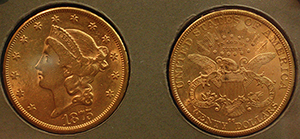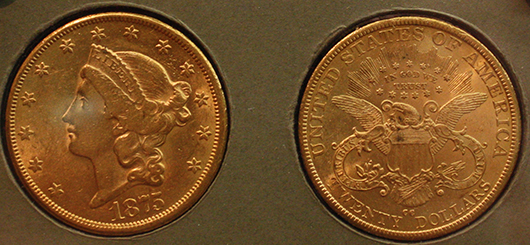
CARSON CITY, Nev. (AP) – The last remnants of a fortune of coins found packed in ammunition boxes in the garage of a recluse who died last summer was auctioned Tuesday for more than $3.1 million—but not before bidders got assurances they could return any of the rare $20 gold pieces that some collectors spotted as counterfeit.
Reno-based Silver State Coin bought three of the six lots offered at the Carson City district courthouse, just a few blocks from the old U.S. Carson City mint. Silver State paid nearly $1.2 million for the most expensive lot that featured 880 $20 gold Saint Gaudens.
The other half of the estate of Walter Samaszko Jr., consisting mainly of gold bullion, sold at auction in February for about $3.5 million.
A cleaning crew that went through his small house after his death in June 2012 found the rare coins at his home in a modest neighborhood where neighbors were shocked to learn the elderly man who kept to himself was sitting on such a treasure.
“Anytime you have the ‘hoarder mentality’ where someone very unassuming is in possession of so much, you sort of say, wow,” said Allen Rowe, the owner of Northern Nevada Coin and Bullion who purchased four of the six lots auctioned earlier this year and picked up two more lots on Tuesday for a total of $816,000.
The auction, which lasted about 30 minutes, was delayed briefly after Rowe said he had spotted at least 20 counterfeit gold coins among the more than 2,000 to be sold. The bidding restarted after Alan Glover, the Carson City clerk-recorder in charge of handling the estate, and estate lawyer Dawn Ellerbrock agreed with five potential bidders that any coins certified as fake could be returned.
The agreement seemed to satisfy Brittany Carlson, who made the winning bid on the most valuable lot on behalf of Silver State Coin.
“If I was buying those fakes blind, it might be different,” she said.
Her plans for the coins?
“Sell them as quick as possible,” she told reporters afterward.
Rowe’s store is directly across the street from the old mint that operated in the late 1800s at the height of the Comstock Lode in nearby Virginia City. He bought two lots of $20 gold Liberty Heads and Indian Heads.
“This was a little trickier because of the counterfeit situation,” Rowe said, noting the counterfeiters did a “fairly good” job on the coins.
Most of the fakes probably were made in the 1970s in Lebanon and elsewhere in the Middle East, Rowe said. Although they likely contain a full troy ounce of gold, they clearly were not made at a U.S. mint, he said.
The Rare Coin Company of America of Willowbrook, Ill., bought one lot of 444 $20 gold Saint Gaudens for $630,000, pushing the value of the overall estate past the $6 million mark.
The fortune, after taxes, will go to Samaszko’s only surviving cousin, Arlene Magdanz, of San Rafael, Calif.
A substitute teacher, Magdanz has not spoken publicly about her new-found riches. Officials were able to track her down using a funeral bulletin at Samaszko’s home that led to his father’s service in Chicago in the early 1960s. Newspaper clippings listed survivors.
Glover said he’s never met Magdanz but had spoken with her by phone before the first auction. Since then, they’ve communicated only through third parties, he said. Her lawyer, John Mulligan of Reno, was in Argentina on Tuesday and could not be immediately reached for comment.
The cleaning crew that discovered the coins from Austria, Mexico and the United States also found meticulous records of Samaszko’s purchases dating to at least 1964.
Neighbors didn’t seem to know him at all, even though he had lived in the house since the 1960s. His mother lived with him until her death in 1992. His bank account stood at $1,200. He had a money market and mutual fund accounts with a combined value of more than $165,000 when it was closed. The three-bedroom, 1,200-square-foot house was sold for $112,000.
“You drive by his home over on Mountain View and it’s a very little, unassuming house,” Rowe said. “You wouldn’t think he had so much. The way he lived was very modest. He was very frugal.”
Samaszko made good investments in gold at a time in the early 1990s into 2000 when gold was still under $500 an ounce, Rowe said.
Copyright 2013 Associated Press. All rights reserved. This material may not be published, broadcast, rewritten, or redistributed.
ADDITIONAL IMAGE OF NOTE


